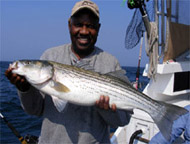 |
|||
|
Wireline Trolling for BassTips and tricks that you can use to improve your results when using this technique.By Chris Bell.Trolling with Wire is a technique used by many anglers in the North East every year for Bass fishing. It is a very useful way to catch fish, but thereís more to it than just motoring around with lines in the water. Know where the fish are, what they are eating and how deep they are can be key to catching fish.Find The Fish. You have to go where the fish are, not where you want them to be. Early morning near structure that has a current that flows past it is the type of area you would be looking for. Places like the Block Island north rip sandbar, and the race south of Fisherís Island in CT are good examples of structure with current. The stronger the sun is, the deeper you will have to go to find bass, as their eyes cannot adjust to varying amounts of light. Donít spend too much time trolling an area if youíre not catching fish, this is a mistake many anglers make. Go to another spot.
Tides And Currents.
Bass love to ambush their prey by hiding out behind some type of
structure and allowing the current to bring something past them. We are
talking about tidal currents, and you need to pay attention to them. It
can be incredible how youíre fishing a spot and catching fish, and as
soon as the tide stops running the fish stop biting, as if someone
turned off a light switch. Tides are critical to catching fish. If
there is no tide, you might as well wait.
|
|
|
|
|
Current can be used to control your trolling speed. Bass love attacking baits that are struggling against the current. By trolling directly into the current, you can slow the boat down to 1 knot or less, simulating struggling fish in the current. Sometimes you only catch fish when trolling in one direction e.g. directly with or against the current. Donít waste time trolling the opposite direction if they show a marked preference for hitting in only one direction, youíre just usingup the bite time available. Trolling depth. This is very important. If fish are holding in 40í of water and youíve only got enough wire out to be 25í deep, youíre not going to catch very many fish. Your rigs must be in the water column at the depth the fish are holding or nearly so. How close depends on how aggressive the fish are at that time of day, it can be as much as 25í or as little as 12Ē. If you see fish smashing bait on the surface, and you canít approach them, try trolling around the edge of the birds and bait with only 100í of wire out. Often larger fish are in slightly deeper water and around the edge of the bait ball looking for injured fish to munch on. In shallow water under 30í it is not necessary to get right down to the bottom, being withing 5í is good enough. Typically you use 10í of wire for every 1í of depth. This can change depending on how slow you go, the slowere the les lne you need for the same depth. In very deep water, it is necessary to get close to the bottom to catch. Matching the hatch. This is absolutely critical. Whatever you use should in some way be similar to the forage that the fish are feeding on that day. This doesnít mean that you wonít catch fish, but if the forage is sand eels and your using an umbrella with 6Ē shads, donít be surprised if you catch less fish than someone using umbrellas with tube rigs on them. Many times if you donít match the hatch, you canít even buy a fish. If you get one in the boat, open up the stomach and see what theyíre eating. Sport Fishing. This is a sport, and you have fun doing it. Donít leave the boat in gear after youíve hooked a fish. Once the angler has the rod in his hand and can reel the line, take the boat out of gear and fight the fish, not the boat. Keep in mind that this wire line, and any slack will allow the fish to get off, as it has no stretch. If you think you lost the fish, reel faster, donít stop reeling under any circumstances. By following these guidelines you should be rewarded with more success on your bass fishing trips. Remember to pay attention to what youíre doing when you hook up, and when not catching, ask yourself, what do I need to change, should I go somewhere else?
|
||
|
copyright 2010 Striper Fishing Charter Boats in Rhode Island |
|||


